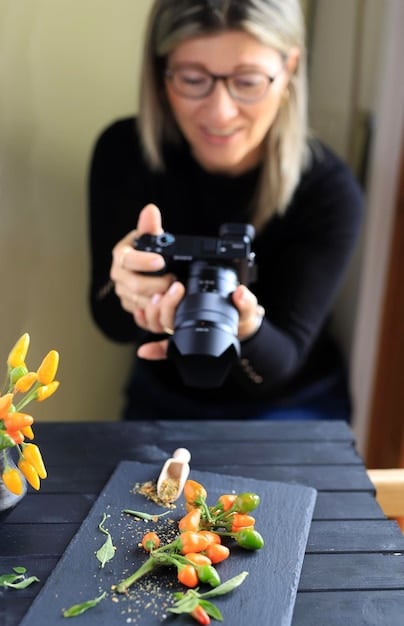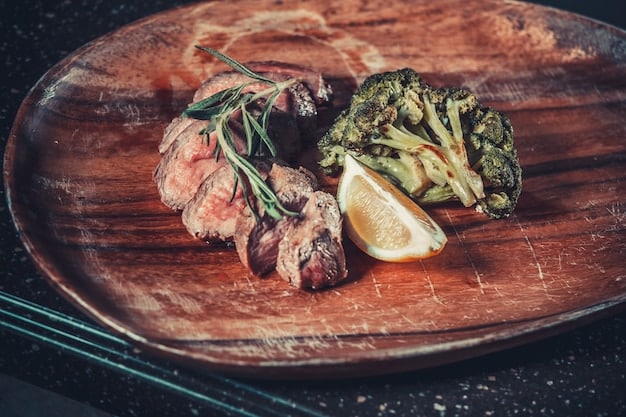Culinary Tourism Certification: Master Food Photography & Recipe Documentation

Achieving culinary tourism certification equips professionals with essential skills in food photography and recipe documentation, vital for enhancing the appeal and authenticity of gastronomic experiences in the tourism sector.
In the vibrant intersection of gastronomy and travel, a new frontier emerges, redefining how we experience cultures through their cuisines. Culinary Tourism Certification: Discover the Art of Food Photography and Recipe Documentation empowers enthusiasts and professionals alike to not just savor dishes, but to visually capture their essence and meticulously preserve their heritage.
Mastering the Culinary Narrative: Why Certification Matters
When discussing the evolving landscape of travel, one cannot overlook the increasing prominence of culinary tourism. It’s no longer sufficient simply to taste a local dish; travelers seek an immersive, authentic experience that connects them to the culture, history, and people behind the food. This pursuit has elevated skilled food photographers and methodical recipe documentarians into invaluable assets within the tourism industry.
A culinary tourism certification typically involves a comprehensive curriculum aiming to bridge the gap between passion for food and professional application in travel. It goes beyond basic cooking classes, delving into the intricacies of food safety, regional culinary histories, and, critically, the art of visual storytelling and heritage preservation through recipes. The credential serves as a testament to an individual’s expertise, assuring tour operators, hospitality providers, and, ultimately, the consumers, of a high standard of knowledge and practice.
Understanding the Core Pillars of Culinary Tourism
At its heart, culinary tourism is about exploration and connection. It’s about understanding the journey of ingredients from farm to fork, appreciating the traditions passed down through generations, and celebrating the unique flavors that define a place.
- Cultural Immersion: Culinary tourism is a gateway to understanding a culture’s heartbeat. It’s about participating in local markets, understanding cooking rituals, and sharing meals.
- Economic Impact: By promoting local producers and traditional eateries, culinary tourism directly supports local economies, creating jobs and fostering sustainable practices.
- Preservation of Heritage: Documenting recipes and food traditions ensures that valuable culinary knowledge isn’t lost but instead preserved for future generations, maintaining authenticity.
The demand for certified professionals in this field reflects a broader trend towards more specialized and authentic travel experiences. Those who undergo certification are better equipped to craft compelling narratives, whether through a captivating photograph or a precisely documented recipe, making the destination’s culinary offerings irresistible. This structured approach to learning ensures that the individual possesses not only the creative flair but also the technical prowess to excel.
The certification process emphasizes practical application, ensuring that graduates are ready to contribute meaningfully from day one. This deep dive into both the theoretical and practical aspects positions certified individuals as true experts, capable of elevating any culinary tourism venture. It’s about building a foundation of knowledge that supports both artistic expression and professional rigor.
The Allure of Food Photography: Capturing Gastronomic Wonders
In an era dominated by visual content, food photography has transitioned from a niche hobby to a crucial skill, especially for those involved in culinary tourism. A single, well-composed photograph can tell a story, evoke emotions, and transport a viewer to a distant table, long before they even plan their trip. For culinary tourism professionals, mastering this art is paramount to showcasing the unique flavors and experiences a destination offers.
Effective food photography is far more than just pointing and shooting. It demands an understanding of lighting, composition, styling, and the nuanced ability to highlight the texture and freshness of ingredients. Certified professionals learn how to manipulate natural light to their advantage, curate compelling arrangements that tell a story, and edit images to enhance their appeal while maintaining authenticity.
Techniques for Visual Storytelling
Consider the difference between a simple snapshot and a meticulously crafted photograph designed to tantalize and inform. The latter is achieved through deliberate choices and a deep understanding of visual rhetoric.
- Natural Lighting: Utilizing diffused natural light is often preferred to create soft shadows and bring out the natural colors of the food, making it appear more appetizing.
- Composition Rules: Applying principles like the rule of thirds, leading lines, and negative space helps create visually balanced and dynamic images that draw the viewer’s eye.
- Styling and Props: The strategic use of plates, cutlery, napkins, and background elements can set the mood and provide context, enhancing the overall narrative of the dish.

Moreover, understanding the cultural context of food is vital. A photograph of street food in Bangkok should convey the bustling energy and vibrant colors of the market, while a shot of a Michelin-starred dish in Paris might emphasize elegance and precision. This cultural sensitivity, often taught in certification programs, ensures that photographs are not only beautiful but also respectful and accurate representations of the culinary experience.
The skill sets acquired through certification extend beyond mere technical proficiency. They cultivate an eye for detail, an understanding of aesthetic principles, and the ability to translate sensory experiences into compelling visual content. This holistic approach ensures that every photograph serves a purpose: to invite, excite, and educate the audience about the destination’s unique culinary offerings.
The Precision of Recipe Documentation: Preserving Culinary Heritage
While stunning visuals draw attention, the meticulous documentation of recipes provides the enduring backbone for culinary tourism. Recipes are more than mere instructions; they are historical artifacts, cultural expressions, and invaluable blueprints for recreating gastronomic experiences. For certified culinary tourism professionals, the ability to accurately and comprehensively document these culinary traditions is as crucial as capturing their visual appeal.
Effective recipe documentation requires a blend of culinary knowledge, investigative journalism, and precise linguistic skills. It involves not just listing ingredients and steps, but understanding the origin of the dish, its cultural significance, variations across regions, and the specific techniques that define its authenticity. This detailed approach ensures that the culinary heritage is preserved and accessible to a wider audience, preventing the loss of traditional knowledge.
Elements of Comprehensive Recipe Documentation
A well-documented recipe goes beyond the basics to provide a richer, more authentic experience for anyone looking to recreate the dish. This rigor is a hallmark of certified expertise.
- Historical Context: Understanding the origins and evolution of a dish, including anecdotal stories or regional variations, adds depth.
- Ingredient Specificity: Precise measurements, quality specifications (e.g., “freshly ground spices” vs. “spices”), and recommended brands or local substitutes.
- Technique Details: Clear, step-by-step instructions, including nuances like “blanch until tender crisp” or “simmer gently,” often accompanied by tips for success.
- Serving Suggestions: Information on traditional accompaniments, plating recommendations, and beverage pairings enhances the overall culinary experience.
The certification process often emphasizes the importance of interviewing local chefs, home cooks, and food historians to gather authentic information. This primary research adds layers of credibility and narrative to the documentation, making the recipes not just functional but also captivating stories in themselves. Ensuring accuracy, accessibility, and cultural respect in documentation is paramount.
By mastering recipe documentation, professionals become guardians of culinary heritage. They enable future generations to experience traditional flavors and allow tourists to take a piece of their culinary journey home with them, recreating memories and sharing newfound appreciation. This skill bridges the gap between tasting and understanding, turning fleeting moments into lasting legacies.
Integrating Skills: Photography, Documentation, and Tourism
The true power of culinary tourism certification lies in its holistic approach, integrating the artistic flair of food photography with the rigorous precision of recipe documentation, all within the framework of travel and hospitality. It’s about leveraging these distinct skills synergistically to create a more profound and appealing culinary travel experience.
When a culinary tourist is browsing potential destinations, a beautifully photographed dish alongside a captivatingly documented recipe can be the decisive factor. The photograph draws them in, promising an aesthetic and sensory delight. The recipe, with its detailed background and instructions, offers a deeper connection, hinting at the possibility of recreating that experience or understanding its cultural significance.
Certified professionals become adept at curating entire culinary narratives. They can photograph a bustling local market, document the process of a traditional dish being prepared, capture the finished masterpiece, and then provide a thoroughly researched recipe that allows the traveler to replicate the experience at home. This seamless integration enhances the marketing, educational, and experiential value of culinary tours.
Impact on Travel and Hospitality
The skills acquired through certification benefit not only the individuals but also the broader industry by elevating the quality and authenticity of offerings.
- Enhanced Marketing: High-quality visuals and compelling narratives attract more tourists, differentiating culinary tours and destinations.
- Educational Value: Documented recipes and explanations enrich the tourist’s understanding of local cuisine, fostering a deeper appreciation and connection.
- Brand Building: Businesses hiring certified professionals can build a reputation for authenticity, quality, and comprehensive culinary experiences.

Furthermore, this integrated approach contributes significantly to sustainable tourism. By accurately documenting and promoting traditional dishes, certified professionals help perpetuate local food economies and culinary traditions, ensuring they thrive amidst growing tourism. It moves beyond mere consumption to true cultural exchange and preservation.
The ability to seamlessly weave these disciplines together is what sets certified culinary tourism specialists apart. They don’t just promote food; they tell its story, honor its origins, and invite others to become a part of its ongoing journey. This integrated methodology creates an enriched experience for travelers, leaving them with lasting memories and a tangible connection to the places they visit through shared food.
The Certification Journey: What to Expect
Embarking on a culinary tourism certification journey is a commitment to professional growth and deep immersion in the world of food and travel. While specific programs may vary, a common thread involves a blend of theoretical knowledge, practical skill development, and often, real-world application through projects or internships. This comprehensive approach ensures graduates are well-rounded and ready to contribute to the dynamic culinary tourism sector.
Typically, the curriculum covers a wide array of subjects. Prospective students can expect modules on global food traditions, sustainable tourism practices, marketing and branding for culinary experiences, and advanced techniques in both food photography and recipe documentation. Many programs also emphasize business aspects, preparing individuals to launch their own ventures or consult for existing hospitality businesses.
Key Program Components
Certification programs are designed to be intensive and highly practical, equipping students with a diverse toolkit of skills.
- Curriculum Depth: Covering everything from the history of global foodways to advanced digital imaging for food and meticulous recipe writing standards.
- Hands-on Training: Workshops focused on camera settings, lighting techniques, food styling, and practical sessions on recipe testing and verification.
- Industry Connections: Opportunities for networking with established professionals, guest lectures by industry leaders, and potential internships with culinary tour operators or food media companies.
The evaluation process often includes a combination of assignments, practical projects, and examinations. For example, students might be tasked with creating a portfolio of food photographs from a specific region, or documenting a complex traditional recipe from scratch, including historical research and step-by-step visual guides. These assessments are designed to test both theoretical understanding and practical application.
Choosing the right certification program involves researching institutions that align with one’s career goals and values. Accreditation, faculty expertise, alumni networks, and program flexibility (e.g., online versus in-person) are all critical factors to consider. Ultimately, the certification journey is about transforming a passion for food and travel into a recognized, professional skill set.
Career Pathways with Culinary Tourism Certification
Obtaining a culinary tourism certification opens up a diverse array of exciting career possibilities within the rapidly expanding travel and hospitality industries. Far from limiting options, this specialized credential broadens horizons, empowering individuals to pursue roles that blend their love for food with their passion for exploration and cultural exchange.
Graduates often find themselves in positions that require a keen eye for detail, strong communication skills, and an in-depth understanding of culinary traditions. The expertise in food photography and recipe documentation specifically makes them indispensable assets for organizations looking to authentically represent and market their gastronomic offerings. This versatility allows for movement across various sectors within tourism.
Diverse Professional Roles
The specialized skill set provided by certification equips professionals for numerous dynamic roles where food and travel intersect.
- Culinary Tour Operator: Designing, leading, and marketing immersive food-focused travel experiences globally.
- Food Content Creator: Developing compelling visual and written content for blogs, magazines, hospitality brands, and tourism boards.
- Restaurant and Hotel Consultant: Advising establishments on menu development, culinary branding, and creating unique gastronomic guest experiences.
- Culinary Educator: Teaching classes on food photography, recipe writing, or specific regional cuisines to amateur enthusiasts or aspiring professionals.
Furthermore, the entrepreneurial spirit is often fostered within these programs, leading many certified individuals to launch their own ventures. This could range from independent food photography studios specializing in restaurant branding, to publishing their own cookbooks or creating niche culinary travel blogs that blend stunning visuals with meticulously researched recipes.
The certified professional becomes a bridge between local culinary traditions and global audiences. Their skills ensure that gastronomic heritage is not only celebrated but also accurately and appealingly presented, contributing significantly to the cultural understanding and economic vitality of destinations worldwide. The demand for such specialized expertise is only set to grow as culinary tourism continues its upward trajectory.
Future Trends: Innovation in Culinary Storytelling
As culinary tourism continues to evolve, innovation in storytelling will be key to engaging audiences and preserving gastronomic heritage. The future of this field lies in leveraging emerging technologies and creative approaches to enhance how food is experienced, documented, and shared. Certified professionals will be at the forefront of these advancements, utilizing their specialized skills in new and dynamic ways.
One significant trend is the rise of immersive digital experiences. Virtual reality (VR) and augmented reality (AR) are beginning to offer ways for potential travelers to “taste” and “see” dishes before they even book their trip. This provides immense opportunities for masterful food photography and detailed recipe documentation to create highly engaging pre-travel content. Think of a VR tour of a bustling Thai market, culminating in a detailed AR overview of how to prepare Pad Thai, complete with clickable ingredients.
Another area of growth involves personalized culinary journeys driven by data analytics. Understanding traveler preferences will allow for highly tailored food experiences, and the ability to photograph and document these specific, niche culinary interests will be invaluable. This moves beyond mass tourism to hyper-targeted, authentic experiences.
Emerging Technologies and Creative Approaches
The landscape of culinary storytelling is rapidly transforming, offering exciting new avenues for certified professionals.
- Interactive Recipes: Digital recipes enhanced with video tutorials, 360-degree views of preparation steps, and interactive ingredient lists.
- AI-Enhanced Photography: Using artificial intelligence to assist with editing, composition suggestions, and even generating styling ideas for food shots, streamlining workflows.
- Blockchain for Provenance: Employing blockchain technology to document the origin and authenticity of ingredients for premium culinary experiences, enhancing trust and transparency.
The emphasis will increasingly be on authenticity and sustainability. Consumers are more conscious about the ethical sourcing of food and the environmental impact of their travel. Certified culinary tourism professionals, with their deep understanding of local food systems and cultural nuances, are perfectly positioned to highlight these aspects through their photography and detailed documentation.
The continuous evolution of digital platforms also means new avenues for sharing culinary stories. From short-form video content on platforms like TikTok and Instagram Reels requiring concise, visually impactful storytelling, to long-form documentary series delving deep into the history of a single dish, the demand for high-quality visual and documented gastronomic narratives will only intensify. Culinary tourism certification provides the foundational skills to adapt and thrive in this innovative future.
| Key Aspect | Brief Description |
|---|---|
| 📸 Food Photography | Mastering visual storytelling to capture dish essence and allure. |
| 📝 Recipe Documentation | Accurately preserving culinary heritage through detailed, historical recipes. |
| 🗺️ Culinary Tourism Impact | Enhancing destination appeal and cultural understanding through gastronomy. |
| 📈 Career Growth | Unlocking diverse roles from content creator to tour operator in food travel. |
Frequently Asked Questions
▼
Culinary tourism certification is a specialized credential that validates an individual’s expertise in various aspects of gastronomy and travel. It typically covers subjects like food history, cultural nuances, sustainable practices, and essential skills such as food photography and precise recipe documentation, preparing professionals for the niche market of food-focused travel experiences.
▼
Food photography is crucial for culinary tourism as it visually engages potential travelers, conveying the authenticity and appeal of local dishes. High-quality images can evoke emotions, tell a compelling story about a destination’s cuisine, and act as a powerful marketing tool, enticing individuals to explore a region through its unique gastronomic offerings and traditions.
▼
Recipe documentation contributes significantly by preserving culinary heritage and allowing travelers to recreate their gastronomic experiences at home. Beyond basic instructions, it often includes historical context, cultural significance, and precise techniques, turning recipes into valuable artifacts that deepen understanding and connection to a destination’s food traditions, fostering lasting appreciation.
▼
With a culinary tourism certification, diverse career opportunities open up. Professionals can become culinary tour operators, food content creators for blogs or magazines, consultants for hospitality businesses, or even culinary educators. The specialized skills in photography and documentation are highly valued in marketing, preserving, and promoting authentic food experiences to a global audience.
▼
Yes, certification programs emphasize skills for ensuring authenticity in documentation. These include thorough research methods, interviewing local chefs and food historians, and meticulous attention to detail in ingredient sourcing and traditional preparation techniques. The goal is to accurately capture the cultural nuances and historical context of dishes, preventing misrepresentation and preserving genuine culinary heritage.
Conclusion
The realm of culinary tourism is undergoing a remarkable transformation, driven by a growing appetite for authentic and immersive gastronomic experiences. As demonstrated, achieving a culinary tourism certification is not merely an academic exercise; it represents a strategic investment in skills that are increasingly vital for navigating and shaping this dynamic industry. The mastery of food photography and the precision of recipe documentation are twin pillars that empower professionals to tell compelling culinary stories, preserve invaluable heritage, and ultimately, enrich the travel experiences of countless individuals. By blending artistic flair with meticulous research, certified experts are poised to elevate culinary tourism, transforming fleeting tastes into lasting memories and profound cultural connections, ensuring that the art of food continues to captivate and inspire future generations of global travelers.





